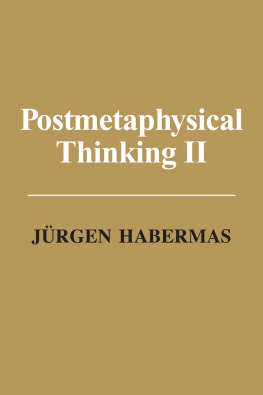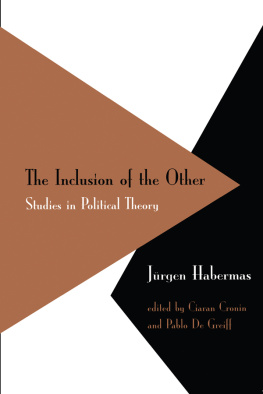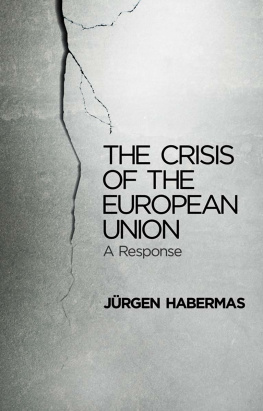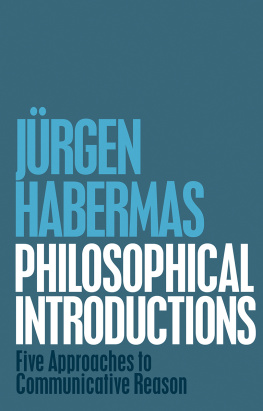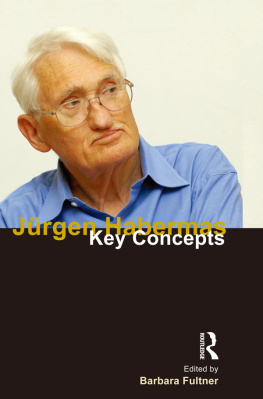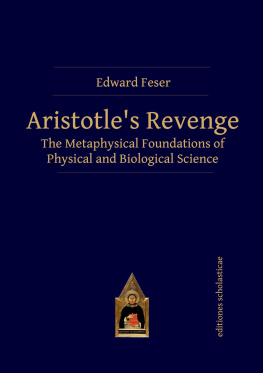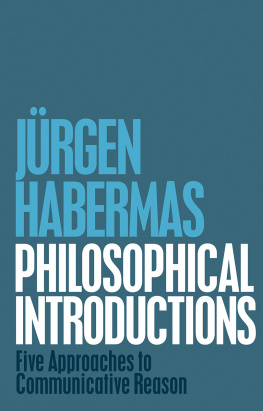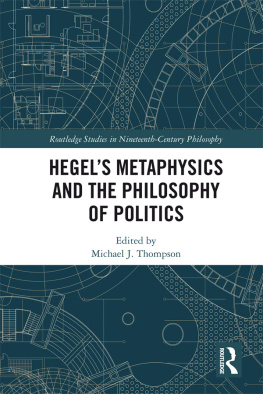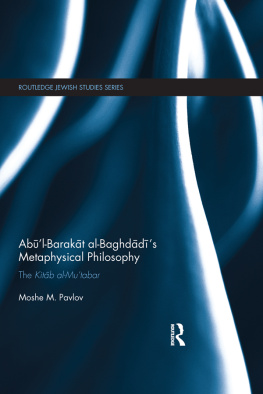Contents
Guide
Pages

Postmetaphysical Thinking II
Essays and Replies
Jrgen Habermas
Translated by Ciaran Cronin
polity
First published in German as Nachmetaphysisches Denken II. Aufstze und Repliken Suhrkamp Verlag, Berlin, 2012
This English edition Polity Press, 2017
Polity Press
65 Bridge Street
Cambridge CB2 1UR, UK
Polity Press
350 Main Street
Malden, MA 02148, USA
All rights reserved. Except for the quotation of short passages for the purpose of criticism and review, no part of this publication may be reproduced, stored in a retrieval system or transmitted, in any form or by any means, electronic, mechanical, photocopying, recording or otherwise, without the prior permission of the publisher.
ISBN-13: 978-0-7456-9493-1
A catalogue record for this book is available from the British Library.
The publisher has used its best endeavours to ensure that the URLs for external websites referred to in this book are correct and active at the time of going to press. However, the publisher has no responsibility for the websites and can make no guarantee that a site will remain live or that the content is or will remain appropriate.
Every effort has been made to trace all copyright holders, but if any have been inadvertently overlooked the publisher will be pleased to include any necessary credits in any subsequent reprint or edition.
For further information on Polity, visit our website: politybooks.com
LINGUISTIFICATION OF THE SACRED
In Place of a Preface
The collection of essays published in 1988 under the same title as the present collection dealt with the self-confirmation of philosophical thinking. This remains the theme of the present collection. Philosophy is not a scientific discipline that could be defined in terms of a fixed method or a set subject matter. Philosophical discourses derive their unity instead from the formation of a canon in other words, from the texts that have been associated with the history of philosophy for two and a half millennia. What philosophy can achieve is therefore an essentially contested question. Nevertheless, this is not an idle question that we can sidestep. For even a form of thought that is not determinate must tie itself down for the time being if it is not to wander around aimlessly.
A cursory examination of our scientific, cultural and social context already tells us that philosophers no longer keep company with poets and thinkers. The role of the sage or seer who like Heidegger still claims privileged access to the truth is no longer an option for them. Since philosophy has also joined the ranks of modern scientific disciplines, philosophers begin their efforts at persuasion among their peers. Anyone who does not withstand the tribunal of professional criticism is rightly suspected of charlatanism. Today philosophical arguments, too, can expect to be accepted as prima facie worthy of consideration only in the context of the established discourses of the natural, social and human sciences, of existing practices of art criticism, legal discourse, and political and public communication. Only in this wider context of intrinsically fallible knowledge can we seek the narrow path on which philosophical reasons still count.
But this search must assume a performative form that is, by actually engaging in philosophy; metatheoretical considerations remain abstract in the pejorative sense. Anyone who wants to engage in the Authors for whom the question is problematic rather than one that admits of conclusive answers, too, can differentiate philosophical from other forms of thought only by trying to show what philosophy actually is. For example, I could not justify my recommendation that philosophy should henceforth be conducted only in the mode of postmetaphysical thinking without at the same time arguing for the concept of communicative reason. This is why Postmetaphysical Thinking II opens with a systematic section on The Lifeworld as a Space of Reasons (just as the earlier volume began with a corresponding section on the pragmatic turn).
I now approach the same theme from an evolutionary perspective, however, because a different constellation has developed over the past two decades. The philosophical scene at the time was dominated by trends towards a return to metaphysics. On the one hand, there were some nuanced attempts to return to speculative ideas in response to the deflationary schools of thought of analytic philosophy one proposal was to rehabilitate metaphysical figures of thought by drawing directly on classical sources; As things now stand, political and historical developments over the past decades have lent topicality to a completely different theme. In the wake of globalization and digitalized communication, the largely secularized societies of Europe are confronted with religious movements and forms of fundamentalism of undiminished vitality both at home and throughout the world.
This development has not only steered the discussion in social science on secularization and social modernization in a different direction; it also poses a challenge for philosophy in two respects.religious doctrines, in spite of their archaic roots in ritual practices, seem to be asserting themselves at the heart of social modernity as a contemporary, culturally productive intellectual formation? Philosophy cannot fail to be disconcerted by this contemporaneity of religion because a relationship of parity between philosophy and religion would profoundly alter the constellation that became established in the eighteenth century. Since that time, philosophy, in an alliance with the sciences, had either treated religion as an obscure object in need of explanation (as did Hume, for example) or subsumed it under its own concepts as a past but transparent intellectual formation (as from Kant to Hegel). But now, by contrast, philosophy encounters religion not as a past but as a present-day formation, however opaque. What does this mean for philosophys self-understanding?
The first chapter in the present volume, From Worldviews to the Lifeworld, throws light on the change in the constellation formed by philosophy and science. In this essay, the hard-core scientistic self-understanding of philosophy proposed by advocates of a scientific worldview provides an occasion for defending a soft version of naturalism. The new debate over naturalism calls to mind the aspects under which philosophy, as a scientifically imbued discursive understanding of ourselves and the world, differs from the objectifying sciences. Here, in the context of a rough sketch of the emergence of postmetaphysical thinking out of the symbiosis between faith and knowledge, I develop the basic concepts of communicative action and symbolically structured lifeworld.
The following two essays in the first section present a more in-depth account of this communicative approach from an evolutionary perspective. Michael Tomasello explains the development of human communication out of contexts of cooperation in which the participants coordinate their intentions and actions via simple symbolic gestures.about values and reciprocal normative expectations. In any case, the dimension of obligations requires a special explanation.
The hypothesis that language originates in gestural communication directs our attention to ritual practices, which seem to have supplemented everyday communication as an extraordinary form of communication. Even though this form of communication deviates conspicuously from everyday communication in being decoupled from all tangible functional contexts and not referring to inner-worldly objects and states of affairs, it exhibits structural similarities to gestural communication. Durkheim already identified these ritual practices as the source of social solidarity. This suggests the following hypothesis. As gestural communication developed into fully fledged grammatical languages, ritually generated normative binding energies could be captured and explicated in this fully differentiated linguistic medium. At any rate, the illocutionary forces of many regulative speech acts (such as commanding and promising, appointing, putting into force, etc.) can be understood as the result of a conventionalization of meanings of ritual origin through which they become routines. J. L. Austin developed the concept of illocutionary force with reference to examples of institutionally bound speech acts such as baptizing, swearing, praying, proclaiming, marrying, etc., whose sacred background is evident.

